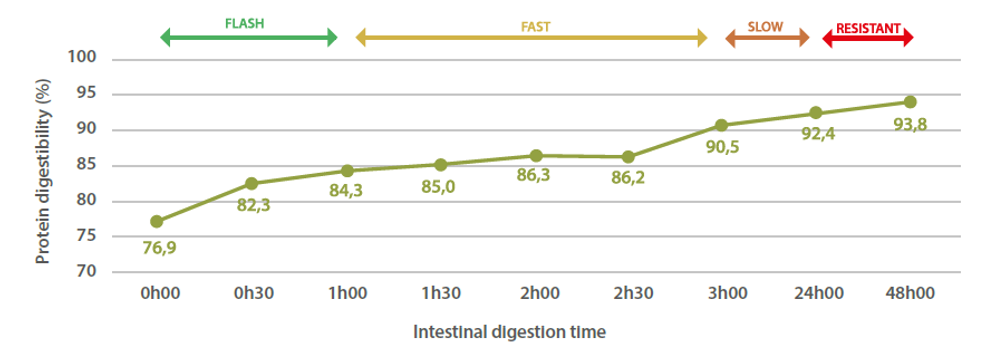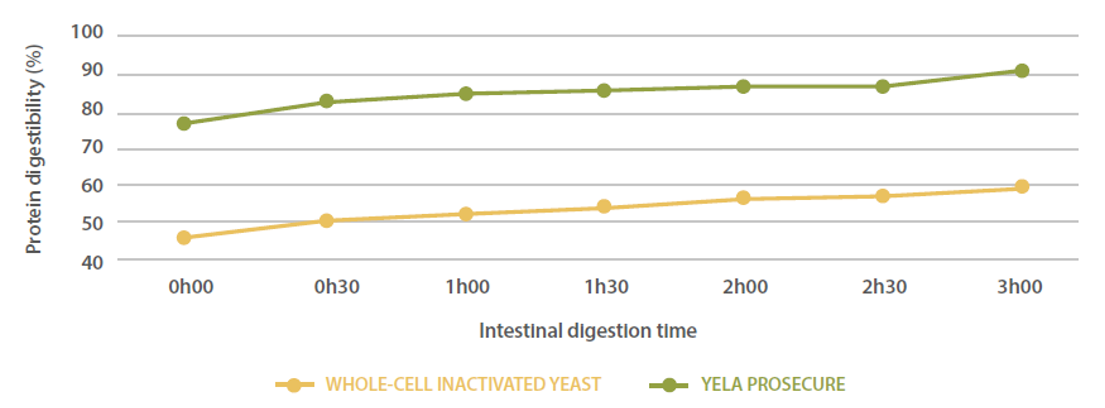



Protein digestibility: a key criterion for discriminating protein sources in feeds
The potential of a functional hydrolyzed yeastIntroduction
The world population is expected to reach 8.5 billion people in 2030, and the projection for 2050 is 9.1 billion (United Nations, 2007). To meet this population’s need for food, animal production is also increasing.
To cope with this challenge, the animal feed industry will need more feed, including protein sources. However, competition with human-edible proteins, pressure on agricultural land, sustainability and climate changes are factors limiting the development of conventional protein sources. Therefore, alternative protein sources are needed to supply the animal nutrition market demand.
About protein digestibility
Proteins are biological macromolecules made up of amino acids. Protein bioavailability is strongly related to its amino acid composition, size, and mass range. Big proteins, protein-associated molecules and nucleic acids have lower digestibility compared to free amino acids and small peptides, which have been exposed to a multiple nitrogen hydrolysis process that makes them more bioavailable (Figure 1).

The digestion process is complex. It is driven by enzymatic activities and is pH dependent. In monogastric animals, this process starts in the stomach where protein denaturation occurs thanks to pepsin activation. In the duodenum, pancreatic and intestinal wall enzymes continue the digestion process, breaking down the proteins. The absorption of amino acids, dipeptides and tripeptides occurs in the jejunum. The large intestine is the location of microbial fermentation, where short chain fatty acids (SCFA) are produced.
Supplying animals with a protein source that is already processed and rich in free amino acids and small peptides helps ensure better absorption in the gut.
The importance of absorption kinetics
Protein digestibility of feed materials is an important information for nutritionists, but it is not expressing timing of absorption in the gut. The kinetics of protein absorption should be considered in addition to protein digestibility. It allows to nutritionists to properly assess the quality of the protein source. Many properties and functionalities of proteins are related to their absorption kinetics. The kinetics of protein absorption helps categorize the protein fraction according to its speed of absorption. Four categories can be defined as flash, fast, slow and resistant along the digestive tract (Figure 2).

Flash digestibility is important for young animals, especially as their gut is not yet mature and still not able to easily absorb and utilize the protein fraction from the diet. Supplying young animals with a flash digestible protein source that is rich in free amino acids and small peptides will help them easily absorb and use those nutrients.
Hydrolyzed yeasts: a source of highly digestible and quickly absorbed proteins
Yeast is an incredible bioengineering factory and a source of valuable nutrients and functional molecules. Yeast experts at Lallemand have worked on the screening of different yeast biomasses and on the optimization of their production processes, both of which led to the development of a specifically designed hydrolyzed yeast, YELA PROSECURE.
YELA PROSECURE’s kinetics of protein absorption has been analyzed with the Boisen standard method (Figure 3). YELA PROSECURE’s protein digestibility starts at 77% at the beginning of the intestinal phase (right after the stomach) to 94% after 48 hours. Moreover, YELA PROSECURE is close to its maximum in vitro digestibility after 3 hours of intestinal digestion, meaning 90.5% of the protein content of YELA PROSECURE has flash and fast digestibility kinetics and only 9.5% is slow and resistant. The proteins from YELA PROSECURE are, therefore, highly bioavailable for the animals.

Effect of the yeast process on the protein digestibility kinetic
The protein digestibility kinetic of YELA PROSECURE was compared to a whole-cell inactivated yeast (Figure 4) with a focus on the three first hours of the intestinal phase as the process of digestion is already quite complete at that time for young animals.
In whole-cell inactivated yeasts, no lysis process is applied, and most nutrients (including the proteins) are in the cytoplasm of the yeast cell making them less accessible. As shown in Figure 5, their protein digestibility is low right after the stomach (46%) and increases slowly, up to 60% after 3 hours.
Thanks to the oriented and controlled hydrolysis process used to produce YELA PROSECURE, proteins and nucleic acids are fragmented into small size peptides offering highly digestible nutrients. We can conclude the yeast lysis process strongly benefits protein digestibility and therefore nutrient bioavailability in the gut.

Hydrolyzed yeast protein digestibility compared to other feed materials
Eight feed materials were assessed for protein digestibility and kinetics of absorption based on the Boisen method. Figure 5 shows that the digestibility kinetics of the protein sources is specific to the different feed materials:
- The whey protein concentrate (WPC) reaches its maximum digestibility level right after the stomach. It is a high-quality protein source even if the crude protein content is low (35%). Additionally, WPC volumes are limited and prices are high.
- Blood plasma also shows fast kinetics of protein digestibility, close to 100 % after 1 hour 30 minutes in the intestine.
- Soybean meal starts with a 50% protein digestibility after the stomach and increases up to 70% after 3 hours of the intestinal phase.
- The kinetics of protein digestibility for fish meal is between YELA PROSECURE and soybean meal, starting with 56% digestibility after the stomach to 81% after 3 hours in the intestine.
- Soy protein concentrate (SPC) reaches the same protein digestibility as soybean meal after 3 hours but starts with a lower digestibility after the stomach (41%). This lower initial digestibility may be explained by the process applied to the SPC to reduce the antinutritional factors, which possibly makes the protein more complex and reduces its bioavailability. It is also important to keep in mind the kinetics of protein digestibility in SPC is dependent on the origin and process applied to the product. Several SPC sources are available in the market.
- The potato protein concentrate appears to have a lower digestibility after the stomach (40%) and slower kinetics of protein digestibility over time (52% at 3 hours of the intestinal phase). Being rich in crude protein (77%), the potato protein concentrate will contribute to a high amount of non-digested protein in the animal gut.
Compared to these feed materials, YELA PROSECURE shows interesting kinetics of protein digestibility with more than 90% of the proteins digested after 3 hours of the intestinal phase.
One direct consequence of that is a negligeable amount of non-digested protein that reaches the lower gut. YELA PROSECURE is, therefore, a valuable protein source that can help reduce the risk of gut dysbiosis associated with non-digested proteins. In addition, a flash and a fast protein digestibility is important in terms of protein functionality with direct and indirect benefits for the animals.

Benefits of a flash and a fast protein digestibility for animals
Free amino acids are known to be beneficial for digestive health at three main levels:
- Free amino acids and especially the branched chain amino acids (BCAAs) — leucine, isoleucine and valine — are involved in the maintenance of the gut mucosa mass and integrity. When they are quickly absorbed, BCAAs play a positive role on the cellular multiplication by supporting the cell proliferation and the amino acids transporters. The direct consequence is a protein synthesis increase and a reduction of the protein degradation mechanism in the intestinal crypts (Duan et al., 2018)
- Glutamic acid, glutamine and glycine help support microbiota growth
- Arginine, glutamine, methionine, tryptophane and threonine help support the gut immune system activity as the gut contains around 70% of the total immune cells of the body.
A concrete example for piglets around weaning:
In this high growth period, the synthesis and protein content in the gut is increasing at the same time as an important amino acid metabolism reshaping is happening at the gut level. The requirement in arginine increases and the risk of shortage is real (Wu and Knabe, 1995).
The systemic inflammation and associated infections sometimes related to the weaning (challenging conditions and environmental stress) lead to an increase in tryptophane, cystine and methionine as well as threonine (Trevisi et al., 2012; Rahhshandeh et al., 2019; Trevisi et al.,2015; Jayaraman, 2019).
At the same time, piglet diets evolve toward a reduction of the crude protein content but with the producer goal of maintaining animal growth performance. To achieve this goal, it is crucial to use highly digestible protein sources which help reduce the crude protein content of the diet while maintaining the digestible protein level associated with high functionalities for the animal.
During this specific period, nutritionists are looking for highly digestible protein sources with fast kinetics of protein absorption, which supply free primary and secondary amino acids.
YELA PROSECURE helps manage dietary amino acids to optimize intestinal homeostasis, which is essential during stressful periods.
Conclusion
Hydrolyzed yeasts are a promising and innovative functional protein source to consider, mainly driven by the free amino acids and the small peptides obtained from the cracking process of the protein. When the hydrolysis process is controlled, yeast bring a standardized profile of free amino acids, which plays a positive role in the maintenance of animal gut health, contributing to the feed protein balance and enhancing feed appetibility. This is particularly of interest when applied to the diets of young animals.
To learn more, check out our new video where Lisa SAIBI, Product Manager for Yeast Derivatives and Antioxidants, and Emmanuelle APPER, Head of Center of Excellence for R&D, share their insights on the increasing demand for alternative protein sources, the innovative hydrolysis technology behind YELA PROSECURE, and the benefits our product offers to nutritionists, such as improved digestibility kinetics and enhanced animal performance.
References available upon request.










